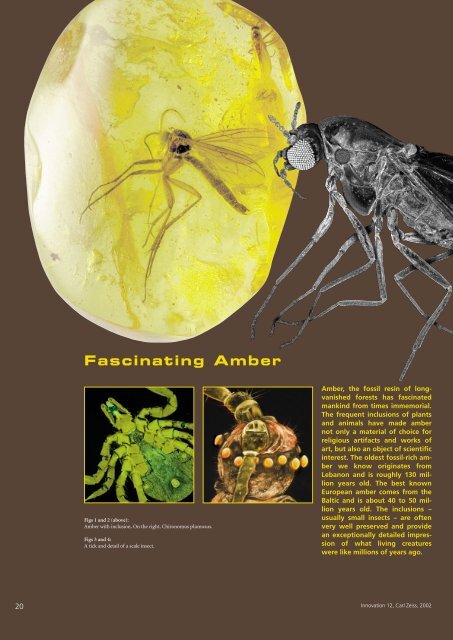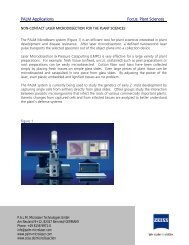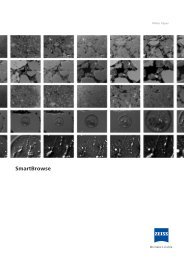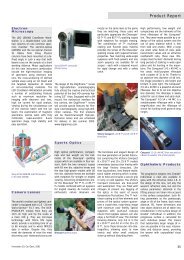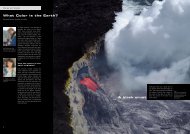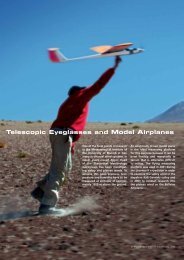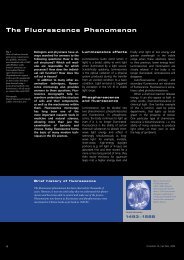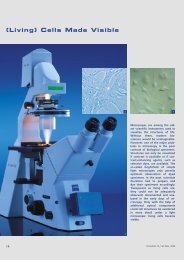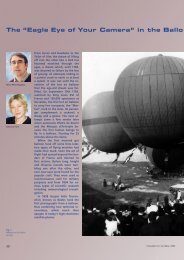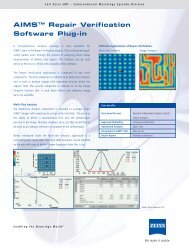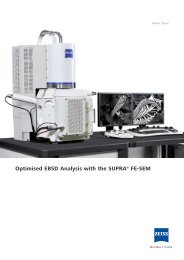Fascinating Amber - Carl Zeiss, Inc.
Fascinating Amber - Carl Zeiss, Inc.
Fascinating Amber - Carl Zeiss, Inc.
Create successful ePaper yourself
Turn your PDF publications into a flip-book with our unique Google optimized e-Paper software.
<strong>Fascinating</strong> <strong>Amber</strong><br />
Figs 1 and 2 (above):<br />
<strong>Amber</strong> with inclusion. On the right, Chironomus plumosus.<br />
Figs 3 and 4:<br />
A tick and detail of a scale insect.<br />
<strong>Amber</strong>, the fossil resin of longvanished<br />
forests has fascinated<br />
mankind from times immemorial.<br />
The frequent inclusions of plants<br />
and animals have made amber<br />
not only a material of choice for<br />
religious artifacts and works of<br />
art, but also an object of scientific<br />
interest. The oldest fossil-rich amber<br />
we know originates from<br />
Lebanon and is roughly 130 million<br />
years old. The best known<br />
European amber comes from the<br />
Baltic and is about 40 to 50 million<br />
years old. The inclusions –<br />
usually small insects – are often<br />
very well preserved and provide<br />
an exceptionally detailed impression<br />
of what living creatures<br />
were like millions of years ago.<br />
20<br />
Innovation 12, <strong>Carl</strong> <strong>Zeiss</strong>, 2002
details<br />
<strong>Amber</strong><br />
The often very small inclusions are<br />
usually studied under stereomicroscopes<br />
in reflected or oblique light.<br />
However, the resolutions achieved in<br />
this way are often not sufficient to<br />
identify minute morphological structures<br />
(e. g. mandibles, genital organs,<br />
extremities) required for the systematic<br />
classification of insects.<br />
Other microscopic methods can<br />
hardly be used for this purpose:<br />
transmitted-light examinations are<br />
unsuitable due to the thickness and<br />
material of the specimens involved,<br />
while reflected-light examinations are<br />
impaired by reflection, refraction and<br />
schlieren in the amber. At high magnifications,<br />
the complex 3D structure<br />
is almost completely superposed by<br />
stray light from non-focal planes.<br />
Scientifically speaking, amber is a<br />
biolith (bios – life, lithos – stone)<br />
and is found in all continents<br />
except the ice-covered Antarctic.<br />
Arguably the most famous amber<br />
comes from the Baltic, the “mare<br />
balticum“. Ancient records<br />
frequently describe it as “gold of<br />
the north“, and Nordic sagas<br />
speak of “tears of the sea“. The<br />
most abundant deposits are found<br />
near Kaliningrad and on the<br />
Samland shore.<br />
The Roman Empire also mentions<br />
amber in mythological treatises,<br />
describing it as “petrified sun<br />
beams“ or “tears of the gods“.<br />
<strong>Amber</strong> was burnt as incense, its<br />
powder was long considered a<br />
remedy, and under the name of<br />
“eye stone“ pieces of amber were<br />
used as a cure for eye diseases.<br />
<strong>Amber</strong> is the petrified resin of<br />
primeval trees. In the Baltic<br />
region, a species of pine tree from<br />
the tertiary period – pinus<br />
succinifera – is assumed to be the<br />
source of amber. The primeval<br />
plants and animals trapped in<br />
amber are called inclusions.<br />
Apart from its individuality and<br />
paleogeological significance, the<br />
distinctive feature of amber is its<br />
vast and fascinating diversity of<br />
colors which developed over<br />
millions of years of amber<br />
formation, depending on the<br />
crystallization conditions involved.<br />
The color spectrum ranges from<br />
yellow, white, red and green<br />
through blue, brown and black to<br />
silver and gold, and a single piece<br />
of amber may typically display<br />
fascinating color variations besides<br />
its basic color. The scientific facts<br />
Germany<br />
Switzerland<br />
Italy<br />
Poland<br />
Wroclaw<br />
Bouzov Olomouc<br />
Czech Republic<br />
Slovakia<br />
Eisenstadt<br />
Austria<br />
Ljubljana Ptuj<br />
Trieste<br />
Celje<br />
Slovenia<br />
Croatia<br />
Palanga<br />
Nida<br />
Jantarny<br />
Gdańsk<br />
Biskupin<br />
Poznań<br />
Asparn<br />
look far more sober: amber<br />
consists of 67% to 87% carbon,<br />
8.5% to 11% hydrogen and up to<br />
15% oxygen. In addition,<br />
it contains small quantities of<br />
sulphur, turpentine, derivates and<br />
resin acids. The colors of amber<br />
range from honey-yellow to nearly<br />
transparent and dark brown.<br />
<strong>Amber</strong> dissolves in alcohol and<br />
ether, it melts at 300° C and<br />
begins to burn.<br />
Klodzko<br />
Latvia<br />
Lithuania<br />
Russia<br />
Kaliningrad<br />
Malbork<br />
Groß-Schweinbarth<br />
Bratislava<br />
Sopron Hungary<br />
Szombathely<br />
Bosnia-<br />
Herzegovina<br />
Serbia<br />
Fig. 5:<br />
Route of the <strong>Amber</strong> Road<br />
from the Baltic to the<br />
Adriatic.<br />
Innovation 12, <strong>Carl</strong> <strong>Zeiss</strong>, 2002<br />
21
Fig. 6:<br />
Homoptera.<br />
Razor-sharp<br />
images<br />
This is where confocal laser scanning<br />
microscopy opens up totally new possibilities.<br />
A laser beam scans the inclusion<br />
point by point and plane by plane,<br />
and stray light is effectively suppressed<br />
by the confocal pinhole. The instrument<br />
detects either the reflected laser<br />
light or fluorescence produced in the<br />
specimen. The result is a stack of individual<br />
high-contrast planes with minimized<br />
stray light known as optical sections,<br />
permitting 3D reconstruction of<br />
the specimen. The images which are<br />
reminiscent of those obtained with<br />
scanning electron microscopes display<br />
a resolution by far surpassing anything<br />
seen before. This ensures a significantly<br />
higher degree of reliability in systematic<br />
classification, especially of insects.<br />
An accidental<br />
discovery<br />
The excellent suitability of confocal<br />
laser scan microscopy for this highly<br />
specialized application was discovered<br />
more or less by accident. A private<br />
collector contacted <strong>Carl</strong> <strong>Zeiss</strong><br />
to inquire about state-of-the-art examination<br />
methods for amber, enclosing<br />
a few specimens with his<br />
letter. The results obtained were so<br />
impressive that the collector presented<br />
them on his home page in<br />
the Internet. The team of Professor<br />
Rust (now at the University of Bonn)<br />
came across these pictures when<br />
looking for preservation methods to<br />
prevent normal aging in the amber<br />
artifacts of the famous Kaliningrad<br />
collection which is managed and researched<br />
at the University of Göttin-<br />
gen. This was the beginning of a<br />
very fruitful cooperation culminating<br />
in the exhibition “The <strong>Amber</strong><br />
Forest by Laser Light“ at the Goldfuß<br />
Museum of the University of<br />
Bonn. This exhibition was part of<br />
the “Year of Geo-Sciences“ and displayed<br />
a selection of outstanding<br />
photos plus a host of interesting information<br />
about amber and a large<br />
number of valuable original pieces.<br />
The wide coverage in regional<br />
and national newspapers and in different<br />
scientific magazines on TV<br />
testifies to the unbroken fascination<br />
evoked by amber and the creatures<br />
trapped in it millions of years ago.<br />
The European <strong>Amber</strong> Road project –<br />
leading from Palanga to Trieste –<br />
was recently launched in Austria.<br />
22<br />
Innovation 12, <strong>Carl</strong> <strong>Zeiss</strong>, 2002
details<br />
<strong>Amber</strong> – Tears of the Gods<br />
In the second book of his mythological world history entitled<br />
“Metamorphoses“ the Roman poet Publius Ovisius Naso writes in the<br />
chapter “Phaeton“ about tears turning into amber.<br />
… quid faciat mater, nisi, quo trahat inpetus illam,<br />
huc eat atque illuc et, dum licet, oscula iungat?<br />
non satis est: truncis avellere corpora temptat<br />
et teneros manibus ramos abrumpit, at inde<br />
sanguineae manant tamquam de vulnere guttae.<br />
‘parce, precor, mater’, quaecumque est saucia, clamat,<br />
‘parce, precor: nostrum laceratur in arbore corpus!<br />
iamque vale’ – cortex in verba novissima venit.<br />
inde fluunt lacrimae, stillataque sole rigescunt<br />
de ramis electra novis, quae lucidus amnis<br />
excipit et nuribus mittit gestanda Latinis.<br />
Publius Ovidius Naso,<br />
known as Ovid<br />
Ovid was born on March 20, 43 BC<br />
in the small provincial town of<br />
Sulmo (Sulmona) in central Italy.<br />
He was educated in Rome, but<br />
soon devoted himself to poetry,<br />
renouncing a career in law or as a<br />
politician. For reasons uncertain to<br />
this day, he was banished by<br />
Emperor Augustus in 8 AD to Tomi<br />
on the Black Sea where he died in<br />
17 or 18 AD, leaving behind him<br />
an extensive literary legacy.<br />
Figs 7 to 9:<br />
Brachycera (detail).<br />
Trichoptera.<br />
Sciara (detail).<br />
Dr. Christian Böker,<br />
Light Microscopy Division<br />
c.boeker@zeiss.de<br />
Amores (love elegies), Heroides (letters written by mythological heroines<br />
to the men who left them), Ars amatoria (an instructive poem on the<br />
art of love), Remedia amoris (cures for love), Metamorphoses<br />
(a mythological world history centered on transformation), Fasti (the<br />
Roman festive calendar), Tristia (an elegiac poem), Epistulae ex Ponto<br />
(Tristia continued), Ibis (a diatribe on an unnamed enemy in Rome),<br />
Medea (a tragedy), De medicamine faciei feminae (an instructive poem<br />
on facial treatment for ladies), Halieutica (an instructive poem on<br />
fishing), Phaenomena (a poem on celestial phenomena).<br />
Dr. Dieter Brocksch, Service Center<br />
Oberkochen<br />
brocksch@zeiss.de<br />
www.amberroad.net/<br />
Innovation 12, <strong>Carl</strong> <strong>Zeiss</strong>, 2002<br />
23


